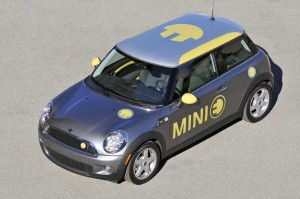
Mini's first battery car, the Mini-E, will be test-marketed in L.A., NYC and New Jersey. If reaction is positive, parent BMW could commit to high-volume production early in the coming decade.
You can understand why Ian Robertson, BMW AG’s board member for marketing and sales, might be charged up about the new Mini-E.
In a Saturday night interview with Robertson during Mini’s 50th Anniversary gala at the Silverstone raceway in England, he excitedly informed me that the first Mini-E, the all electric prototype vehicle, had been delivered to the first lessee in Los Angeles on Saturday, May 23.
When originally revealed, during last Fall’s Los Angeles Auto Show, BMW announced 450 of the all-electric vehicles would be made available this year to 450 applicants, primarily in Los Angeles, New York City & New Jersey, for $850 per month, plus taxes and insurance, early in 2009.
 Peter Treep, the recipient of the special lease car, number 111, has already filed a full blog report on the process of requesting, updating electric service at his home and receiving his Mini E at his blog. Treep will not drive his Toyota Prius during the year he is leasing the $20,000 Mini E.
Peter Treep, the recipient of the special lease car, number 111, has already filed a full blog report on the process of requesting, updating electric service at his home and receiving his Mini E at his blog. Treep will not drive his Toyota Prius during the year he is leasing the $20,000 Mini E.
The delay in delivery of the car was due, noted a Mini public relations spokesperson, to getting needed permits to install the special electric wiring and charger box in the garage to handle the 220 volt current used to quick-charge the Mini’s battery. The pack consists of 5,088 lithium-ion (or LIon) cells, grouped in 48 modules, packaged in three units. Together with a cooler, the battery adds nearly 400 pounds to the weight of the standard Mini. The battery, incidentally, occupies the entire back seat, turning the car into a true 2-seater. GM’s EV1 was a pioneering electric two-seater that failed in the marketplace.
But other than that, there are surprisingly few compromises, as TheDetroitBureau’s Henny Hemmes reported, earlier this year, in a first drive of the Mini-E.With 204 hp and 162 lb.ft of torque, it sprints from 0- 60mph in 8.5 seconds, which is faster than a conventionally-powered Mini Cooper. That is because practically all torque is instantly available and as the electric motor provides its power through a single-speed transmission, the acceleration is constant. But you feel the front wheels struggling for grip and the traction control working really hard. A certain amount of torque steer is noticeable, Hemmes reported, but it’s something she felt you easily get used to.
The problem with this type of set-up, critics maintain, is that range and efficiency are sacrificed for unneeded performance, the age-old auto marketing trick, which keeps increasing our dependency on imported oil from countries sympathetic to terrorists.
With the recent announcement of a 35.5 mpg U.S. fuel economy standard, scheduled to take effect by 2016, there’s a growing push for electric propulsion because they are not rated the same way as gasoline vehicles in the averaging, allowing makers to produce less efficient models. Everyone from Chrysler (click here to see spy shots of the Dodge EV) to Mercedes-Benz to General Motors (click here for a first review of a Chevrolet Volt prototype) is rushing to bring some of battery car to market. Whether consumers will plug in remains to be seen, and makers are pursuing massive taxpayer subsidies, but this real world test of the Mini-E could reveal whether battery technology really does have staying power.
